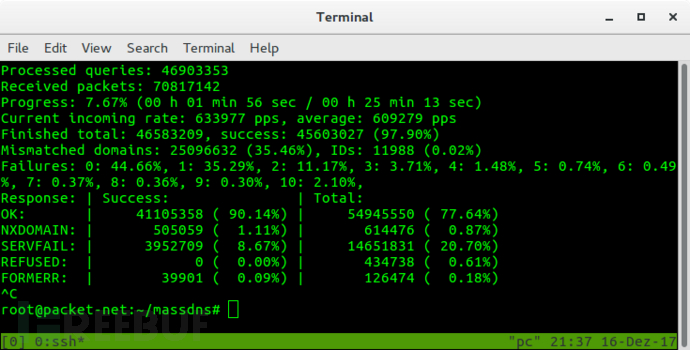

MassDNS是一款功能强大的高性能DNS stub解析工具,它可以帮助研究人员解析数百万甚至上亿个域名。在没有特殊配置的情况下,MassDNS可以利用公共可用的解析器每秒钟解析超过350000个域名。
项目编译
首先,使用下列命令将MassDNS源码克隆至本地目录中:
git clone https://github.com/blechschmidt/massdns.git使用cd命令切换到本地项目目录中:
cd massdns接下来,运行”make”命令构建源码。
如果你使用的不是Linux操作系统,那么则需要运行下列命令:
make nolinux在Windows平台下,你还需要安装Cygwin包、gcc-core、git和make。
工具使用
Usage: ./bin/massdns [options] [domainlist]
-b --bindto Bind to IP address and port. (Default: 0.0.0.0:0)
--busy-poll Use busy-wait polling instead of epoll.
-c --resolve-count Number of resolves for a name before giving up. (Default: 50)
--drop-group Group to drop privileges to when running as root. (Default: nogroup)
--drop-user User to drop privileges to when running as root. (Default: nobody)
--flush Flush the output file whenever a response was received.
-h --help Show this help.
-i --interval Interval in milliseconds to wait between multiple resolves of the same
domain. (Default: 500)
-l --error-log Error log file path. (Default: /dev/stderr)
--norecurse Use non-recursive queries. Useful for DNS cache snooping.
-o --output Flags for output formatting.
--predictable Use resolvers incrementally. Useful for resolver tests.
--processes Number of processes to be used for resolving. (Default: 1)
-q --quiet Quiet mode.
--rcvbuf Size of the receive buffer in bytes.
--retry Unacceptable DNS response codes. (Default: REFUSED)
-r --resolvers Text file containing DNS resolvers.
--root Do not drop privileges when running as root. Not recommended.
-s --hashmap-size Number of concurrent lookups. (Default: 10000)
--sndbuf Size of the send buffer in bytes.
--sticky Do not switch the resolver when retrying.
--socket-count Socket count per process. (Default: 1)
-t --type Record type to be resolved. (Default: A)
--verify-ip Verify IP addresses of incoming replies.
-w --outfile Write to the specified output file instead of standard output.
Output flags:
S - simple text output
F - full text output
B - binary output
J - ndjson output
如果你需要查看更详细的操作选项以及帮助手册(尤其是输出格式),你可以使用“–help”命令。
工具使用样例
解析目标域名(位于lists的resolvers.txt中)的AAAA记录,并将结果存储至result.txt中:
$ ./bin/massdns -r lists/resolvers.txt -t AAAA domains.txt > results.txt或者运行下列命令:
$ ./bin/massdns -r lists/resolvers.txt -t AAAA -w results.txt domains.txt样本输出
默认配置下,MassDNS将会输出响应数据包,格式为文本格式,输出样例如下:
;; Server: 77.41.229.2:53
;; Size: 93
;; Unix time: 1513458347
;; ->>HEADER<<- opcode: QUERY, status: NOERROR, id: 51298
;; flags: qr rd ra ; QUERY: 1, ANSWER: 1, AUTHORITY: 2, ADDITIONAL: 0
;; QUESTION SECTION:
example.com. IN A
;; ANSWER SECTION:
example.com. 45929 IN A 93.184.216.34
;; AUTHORITY SECTION:
example.com. 24852 IN NS b.iana-servers.net.
example.com. 24852 IN NS a.iana-servers.net.
输出结果包含了解析的IP地址,可以帮助我们轻松对输出结果进行过滤。
数据解析
代码库中包含了一个名为resolvers.txt的文件,其中包含了一套有subbrute项目提供的已过滤的解析器子集。请注意,MassDNS的使用可能会提升系统/网络负载,因为需要加载大量解析器,具体将取决于你的ISP。
MassDNS的DNS解析实现目前还不完整,只支持最常见的一些记录类型。欢迎您通过代码贡献来帮助改变这种状况。
PTR记录
MassDNS包含了一个Python脚本,允许我们解析所有的IPv4 PTR记录:
$ ./scripts/ptr.py | ./bin/massdns -r lists/resolvers.txt -t PTR -w ptr.txt请注意,in-addr.arpa中的标签会被反转。为了解析域名为1.2.3.4的地址,MassDNS将需要以“4.3.2.1.in-addr.arpa”的方式来作为输入查询名称。此时,Python脚本并不会按升序解析记录,这样可以避免在IP v4子网的域名服务器上突然出现的负载激增。
网络侦察&爆破子域名
注意:请不要随意使用该工具,适当调整-s参数以避免给权威域名服务器造成负载压力。
跟subbrute类似,MassDNS允许我们使用subbrute.py脚本来对子域名进行爆破枚举:
$ ./scripts/subbrute.py lists/names.txt example.com | ./bin/massdns -r lists/resolvers.txt -t A -o S -w results.txt作为一种额外的网络侦察手段,ct.py脚本可以从crt.sh中抓取数据,并从证书透明日志中提取子域名:
$ ./scripts/ct.py example.com | ./bin/massdns -r lists/resolvers.txt -t A -o S -w results.txt工具运行截图

安全性
MassDNS的运行不需要Root权限, 我们建议用户以非特权用户的身份运行MassDNS。除此之外,我们不建议大家使用“–root”参数来运行。另外,除了Master以外的其他分支不适用于生产环境。
项目地址
MassDNS:【GitHub传送门】
* 参考来源:blechschmidt,FB小编Alpha_h4ck编译,转载请注明来自FreeBuf.COM
如有侵权请联系:admin#unsafe.sh